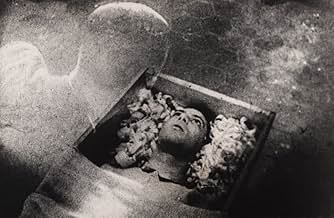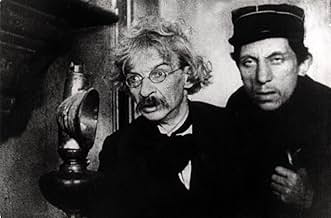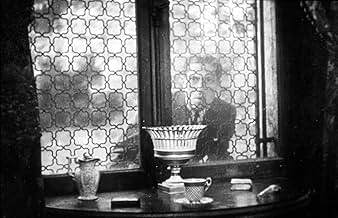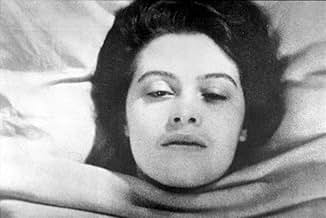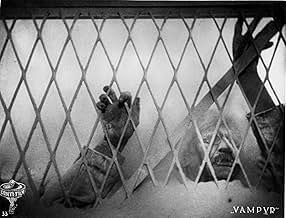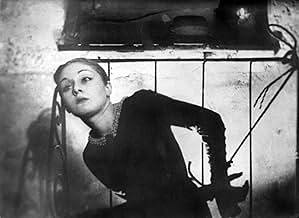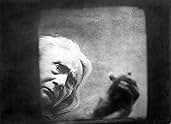A drifter obsessed with the supernatural stumbles upon an inn where a severely ill adolescent girl is slowly becoming a vampire.A drifter obsessed with the supernatural stumbles upon an inn where a severely ill adolescent girl is slowly becoming a vampire.A drifter obsessed with the supernatural stumbles upon an inn where a severely ill adolescent girl is slowly becoming a vampire.
- Director
- Writers
- Stars
- Awards
- 1 win total
Henriette Gérard
- Die alte Frau vom Friedhof (The Old Woman from the Cemetery)
- (as Henriette Gérard)
Kani Kipçak
- Michael
- (uncredited)
- Director
- Writers
- All cast & crew
- Production, box office & more at IMDbPro
Featured reviews
For a movie made in 1932, this is very, very impressive. Confusing plot aside, the emphasis in this Victorian nightmare is placed on the cinematic aspects. "Vampyr" is plodding, very dark and eerie, filled with such haunting atmosphere and brooding visuals full of unseen, but lurking terror - very effecting. It works on a subconscious and emotional level more than any other way. I think it's worth a look.
The major figure of Carl Theodor Dreyer is one of a select group of directors deemed 'transcendental' along with the likes of Ozu and Bresson. Paul Schrader and other critics identify them as those filmmakers who habitually suggest spiritual intensity by ordinary means. Characteristically austere, often using non-professional talent in their films, they find universal truths through a gradual un-dramatic revelation of interior life. All this means in this context is that one would think such directors far away from the flashy supernaturalism and ghastly melodrama normally making up so much of the traditional horror film, a genre where its the extraordinary providing the revelation for the audience, not the mundane. But then one remembers that both Dreyer and Bresson made memorable versions of Joan of Arc, where their representing of terrifying events showed how disturbing an emotionally stark and restrained approach could prove. And, in 1932, about as the first great Universal horror cycle was getting into its stride in Hollywood, Dreyer made his Vampyr.
It is interesting to compare Dreyer's great work with that of Murnau, the only other great director who made a broadly comparable title. Both the German director and the Dane took their inspiration from literary horror classics. Murnau based his Nosferatu (1922) on Dracula while, for his inspiration, Dreyer too turned to an English author: Sheridan le Fanu and his novel Carmilla. But the evil thrill of Nosferatu is that it takes place in a concrete 'reality' of sorts, ghostly special effects notwithstanding. By contrast Vampyr is a strange, dreamlike film, one virtually silent or subdued, despite its soundtrack. Moreover it mainly exists in variable prints, the poor state of which merely adds to the strange dislocatedness of unfolding events portrayed. Dreyer's terror lies in a world of shadows, surreality amplified by some remarkable cinematography, the roots of nightmare ever subtle, where camera movement can excite as much dread and anticipation as any vampire out clawing at a victim.
Vampyr's story, such as it is, tells of Allan Grey (Julian West), a man studious of vampires. In a small French town, he takes a room at an inn. His sleep is interrupted when a strange man (Maurice Shutz) comes into his room speaking disturbingly about death, then leaves a small package with instructions that it should be opened upon his death. Allen gets out of bed, and prowls around the inn and its spooky surroundings in search of an explanation. Eventually he wanders onto a nearby estate where he finds the mysterious man living with his two daughters. A vampire has bitten one of his daughters, and the house is shrouded in death...
Once seen and felt, the peculiarly eerie atmosphere that characterises Dreyer's work is never forgotten. Indeed, Vampyr's influence arguably began at once, for a similar tone of silent mystery pervades some scenes in White Zombie, incidentally one of Bela Lugosi's best, made just the same year - another film which made in sound which often plays like a silent. Like Vampyr, White Zombie includes several wordless sequences which are startlingly eerie and atmospheric. (Both this and present film are much better than Tod Browning's famous version of Dracula also made at about the same time, which these days seem positively wooden by comparison.) And, years later, Ken Russell was to mimic the premature burial sequence of Vampyr, glass windowed coffin and all, in his uneven Mahler while arguably a similar, dreamlike, touch can be found in the work of the French horror auteur Jean Rollin, who in the 1970s made of soft tinted vampirism almost a genre of its own.
Of his original film Dreyer said, "I wanted to create the daydream on film to show that horror is not a part of the things around us, but of our own subconscious mind." To help achieve this, he and his cameraman Rudolph Mate shot much very early in the morning and frequently through fine gauze - a creative decision increasing the sense of mystery surrounding events. The resultant shimmer and softness which fell over scenes suggests the supernatural confusion felt by the hero, and add a spooky disconnectedness to events. Allied to this, as already noted, this is a work where one is acutely aware of camera placement and movement, of shadow and light. Dreyer's sensitive direction means that the lens becomes a lurking accompaniment to Grey's, and therefore our, unease.
Main actor Julian West, who also financed a lot of the picture, makes a suitable impression; part of the mood in what is his only significant film. Forty years later he again appeared again on screen, but with less impact. In retrospect nothing could compare to his appearance here, his pale, Lovecraftian features perfectly in tune with the gloomy goings on. His anonymous freshness as an actor makes of him an everyman, a dramatic unknown fitting in exactly with the director's preferred casting with the undemonstrative and normal. And unlike Nosferatu's celebrated settings of castles, doom laden ships and spectral carriages, Vampyr's unease is primarily set amidst the domestic: an inn, a to-do private home or in common place out-buildings.
Dismayed by distracting subtitles, often faded visuals and poor soundtrack elements, admirers of Dreyer's masterpiece have long cried out in vain for a restored version, especially now that the later films of the director have been reissued. Even such earlier silents such as the lesser, decidedly more obscure, Master Of The House (1925) have lately arrived with a five star treatment on disc. Whether or not this lapse is due to a fatal absence of original materials I am not sure, but fans of one of the very finest horror films, and a rare one by a great director to boot, will not be satisfied until this Vampyr at least is resurrected and given the new life it deserves.
It is interesting to compare Dreyer's great work with that of Murnau, the only other great director who made a broadly comparable title. Both the German director and the Dane took their inspiration from literary horror classics. Murnau based his Nosferatu (1922) on Dracula while, for his inspiration, Dreyer too turned to an English author: Sheridan le Fanu and his novel Carmilla. But the evil thrill of Nosferatu is that it takes place in a concrete 'reality' of sorts, ghostly special effects notwithstanding. By contrast Vampyr is a strange, dreamlike film, one virtually silent or subdued, despite its soundtrack. Moreover it mainly exists in variable prints, the poor state of which merely adds to the strange dislocatedness of unfolding events portrayed. Dreyer's terror lies in a world of shadows, surreality amplified by some remarkable cinematography, the roots of nightmare ever subtle, where camera movement can excite as much dread and anticipation as any vampire out clawing at a victim.
Vampyr's story, such as it is, tells of Allan Grey (Julian West), a man studious of vampires. In a small French town, he takes a room at an inn. His sleep is interrupted when a strange man (Maurice Shutz) comes into his room speaking disturbingly about death, then leaves a small package with instructions that it should be opened upon his death. Allen gets out of bed, and prowls around the inn and its spooky surroundings in search of an explanation. Eventually he wanders onto a nearby estate where he finds the mysterious man living with his two daughters. A vampire has bitten one of his daughters, and the house is shrouded in death...
Once seen and felt, the peculiarly eerie atmosphere that characterises Dreyer's work is never forgotten. Indeed, Vampyr's influence arguably began at once, for a similar tone of silent mystery pervades some scenes in White Zombie, incidentally one of Bela Lugosi's best, made just the same year - another film which made in sound which often plays like a silent. Like Vampyr, White Zombie includes several wordless sequences which are startlingly eerie and atmospheric. (Both this and present film are much better than Tod Browning's famous version of Dracula also made at about the same time, which these days seem positively wooden by comparison.) And, years later, Ken Russell was to mimic the premature burial sequence of Vampyr, glass windowed coffin and all, in his uneven Mahler while arguably a similar, dreamlike, touch can be found in the work of the French horror auteur Jean Rollin, who in the 1970s made of soft tinted vampirism almost a genre of its own.
Of his original film Dreyer said, "I wanted to create the daydream on film to show that horror is not a part of the things around us, but of our own subconscious mind." To help achieve this, he and his cameraman Rudolph Mate shot much very early in the morning and frequently through fine gauze - a creative decision increasing the sense of mystery surrounding events. The resultant shimmer and softness which fell over scenes suggests the supernatural confusion felt by the hero, and add a spooky disconnectedness to events. Allied to this, as already noted, this is a work where one is acutely aware of camera placement and movement, of shadow and light. Dreyer's sensitive direction means that the lens becomes a lurking accompaniment to Grey's, and therefore our, unease.
Main actor Julian West, who also financed a lot of the picture, makes a suitable impression; part of the mood in what is his only significant film. Forty years later he again appeared again on screen, but with less impact. In retrospect nothing could compare to his appearance here, his pale, Lovecraftian features perfectly in tune with the gloomy goings on. His anonymous freshness as an actor makes of him an everyman, a dramatic unknown fitting in exactly with the director's preferred casting with the undemonstrative and normal. And unlike Nosferatu's celebrated settings of castles, doom laden ships and spectral carriages, Vampyr's unease is primarily set amidst the domestic: an inn, a to-do private home or in common place out-buildings.
Dismayed by distracting subtitles, often faded visuals and poor soundtrack elements, admirers of Dreyer's masterpiece have long cried out in vain for a restored version, especially now that the later films of the director have been reissued. Even such earlier silents such as the lesser, decidedly more obscure, Master Of The House (1925) have lately arrived with a five star treatment on disc. Whether or not this lapse is due to a fatal absence of original materials I am not sure, but fans of one of the very finest horror films, and a rare one by a great director to boot, will not be satisfied until this Vampyr at least is resurrected and given the new life it deserves.
Brilliant! Breathtaking! This film was worth the long wait I imposed on myself to see it. It is not the most cohesive narrative about, but it has images that linger with you....haunt you. The film is basically a silent with some speaking. It tells a story about Allan Grey and how he was introduced into a vampire's conspiracy to kill two sisters. Grey is brought in for aid by their father who dies while trying to fight the infection coursing through his daughter's veins. What then follows is pure cinematic magic as Grey...opening a book that the father wrote was to be opened upon his death...begins reading the book on vampires whilst it is going on right around him. The mixture of action and the text from the book create a wonderfully eerie atmosphere and convey a feeling of dread and despair. There are many scenes in Vampyr, directed with fluidity by Carl Dreyer, that are incredibly well-done. The dream sequence in particular explores various camera angles, hitherto not used. As I said before, it is not the tightest story and it has some gaping holes in the plot that are never explained, but that really is not very important because the film succeeds as a film of haunting imagery...fear based on illusion and shadows.
"Vampyr", one of the first horror movies with sound, is the work of the highly influential danish director Carl Theodor Dreyer. After directing the monumental "La Passion de Jeanne d'Arc" in 1928, Dreyer decided to make this modest film based on the novel "In a Glass Darkly" by Sheridan Le Fanu; while this is indeed his first movie with sound, it was conceived as a silent film, and the movie contains very few dialog.
I must admit that as many, I was left with a big question mark in my face as the story was progressing; but the apparently disjointed storyline do make sense, as it is worked as a surreal experience of the lead character, it is as if Dreyer had filmed a nightmare, complete with the haunting images and eerie atmosphere.
The movie is about a traveler, named Allan Grey (Julian West), who gets involved in a nightmarish plot when the owner of the inn where he is staying asks him for help to save his family from what he believes is a vampire. We follow Allan Grey in his surrealistic trip to madness as he finds out more and more about the supposed vampire that haunts the manor turned inn.
The highly inventive camera work is truly outstanding, the combination of light and darkness is among the finest work in a black & white film and alone makes the movie worth a look; the movie not only has the structure of a nightmare, it also looks like one. The Gothic manor and the lonely rural exteriors increase the haunting atmosphere and the beautiful images Dreyer conceived are the work of a genius.
The structure of the script may be complicated, but it shows its influence over David Lynch and other filmmakers with similar surrealist story lines and dreamlike sequences. It is probably not a masterpiece of the likes of the aforementioned "Passion" or the more well-known "Day of Wrath" (Vredens dag, 1943), but "Vampyr" shines with its own light as one of the finest horror movies of that period.
The only real flaw in my opinion, was that the lead actor, Julian West, was probably not the best choice for a lead role, as his acting seems unnatural and not believable. I'm not sure if this was intended that way or had more to do with the fact that West produced the film, but it is my only complain about "Vampyr".
This modest masterpiece is a must see for any horror fan or anyone who likes silent movies. It is a nightmarish trip to the darker parts of the subconscious mind. 8/10
I must admit that as many, I was left with a big question mark in my face as the story was progressing; but the apparently disjointed storyline do make sense, as it is worked as a surreal experience of the lead character, it is as if Dreyer had filmed a nightmare, complete with the haunting images and eerie atmosphere.
The movie is about a traveler, named Allan Grey (Julian West), who gets involved in a nightmarish plot when the owner of the inn where he is staying asks him for help to save his family from what he believes is a vampire. We follow Allan Grey in his surrealistic trip to madness as he finds out more and more about the supposed vampire that haunts the manor turned inn.
The highly inventive camera work is truly outstanding, the combination of light and darkness is among the finest work in a black & white film and alone makes the movie worth a look; the movie not only has the structure of a nightmare, it also looks like one. The Gothic manor and the lonely rural exteriors increase the haunting atmosphere and the beautiful images Dreyer conceived are the work of a genius.
The structure of the script may be complicated, but it shows its influence over David Lynch and other filmmakers with similar surrealist story lines and dreamlike sequences. It is probably not a masterpiece of the likes of the aforementioned "Passion" or the more well-known "Day of Wrath" (Vredens dag, 1943), but "Vampyr" shines with its own light as one of the finest horror movies of that period.
The only real flaw in my opinion, was that the lead actor, Julian West, was probably not the best choice for a lead role, as his acting seems unnatural and not believable. I'm not sure if this was intended that way or had more to do with the fact that West produced the film, but it is my only complain about "Vampyr".
This modest masterpiece is a must see for any horror fan or anyone who likes silent movies. It is a nightmarish trip to the darker parts of the subconscious mind. 8/10
Too often horror films are thought of as light-weight entertainment. Even the best are under-appreciated for what they can tell us about human nature. In the case of Carl Dreyer's "Vampyr," however, all you seem to hear is high-brow rhetoric about how the film's dream-like illogic makes it a meditation upon death. For just once forget all the intellectual mumbo-jumbo and watch this film for what it is, one creepy little flick and the pioneering vampire film of the '30s. It was in production a year before "Dracula" but released the year after, and is a better and scarier film, unless bats on strings scare you.
It's not a silent movie but feels like one - an exceptionally fine one. So if you are put off by non-talking films be warned, dialog is spare, cut to the bone; but the musical score is very good and sinister. The main attractions are the images: shadows that kill people, a spirit that leaves its body, a corpse-eye view of a burial, and other uncanny occurrences that lead young Allan Grey to a girl suffering from a mysterious illness, and to her doctor, a vampire's accomplice who supplies his crone-like patroness with fresh victims.
Possibly the film's poor reception by critics and audiences was because the 1930 soundtrack was too primitive to be appreciated by viewers in 1932, who by then were used to lots of chatter - and because the earlier release of "Dracula" blunted its impact. But with little dialog and without the stagnating influence of a stationary microphone our eyes feast on Hermann Warm's eerie art direction, and are guided by Rudolph Mate's camera, which keeps us off balance, misdirecting our point of view as when it pans to a door through which a nurse exits her patient's room, then pans back again to reveal an empty bed just before the victim's sleep-walking rendezvous with the vampire.
The film bears even less resemblance to its source (Sheridan Le Fanu's "Carmilla") than "Dracula" does to Stoker's novel, possibly because it borrows from another story, Mary Elizabeth Braddon's "Good Lady Ducayne," in which a young man comes to the aid of a young paid female companion of an extremely aged woman whose doctor draws the young woman's blood for his patient to consume. And if "Vampyr's" plot often seems incoherent, so does "Dracula's." The performances, however, are vastly superior. Sybille Schmitz in particular, as the vampire's victim, conveys with her subtle expressions emotions for which spoken language is inadequate.
For those who already know this film, Martin Koerber's restoration on the Criterion release eliminates the large, black-bordered, Gothic subtitles, and corrects the too-bright day-for-night scenes that were so distracting on the Image disc. For others seeing "Vampyr" for the first time, relax, don't think too much, and enjoy!
It's not a silent movie but feels like one - an exceptionally fine one. So if you are put off by non-talking films be warned, dialog is spare, cut to the bone; but the musical score is very good and sinister. The main attractions are the images: shadows that kill people, a spirit that leaves its body, a corpse-eye view of a burial, and other uncanny occurrences that lead young Allan Grey to a girl suffering from a mysterious illness, and to her doctor, a vampire's accomplice who supplies his crone-like patroness with fresh victims.
Possibly the film's poor reception by critics and audiences was because the 1930 soundtrack was too primitive to be appreciated by viewers in 1932, who by then were used to lots of chatter - and because the earlier release of "Dracula" blunted its impact. But with little dialog and without the stagnating influence of a stationary microphone our eyes feast on Hermann Warm's eerie art direction, and are guided by Rudolph Mate's camera, which keeps us off balance, misdirecting our point of view as when it pans to a door through which a nurse exits her patient's room, then pans back again to reveal an empty bed just before the victim's sleep-walking rendezvous with the vampire.
The film bears even less resemblance to its source (Sheridan Le Fanu's "Carmilla") than "Dracula" does to Stoker's novel, possibly because it borrows from another story, Mary Elizabeth Braddon's "Good Lady Ducayne," in which a young man comes to the aid of a young paid female companion of an extremely aged woman whose doctor draws the young woman's blood for his patient to consume. And if "Vampyr's" plot often seems incoherent, so does "Dracula's." The performances, however, are vastly superior. Sybille Schmitz in particular, as the vampire's victim, conveys with her subtle expressions emotions for which spoken language is inadequate.
For those who already know this film, Martin Koerber's restoration on the Criterion release eliminates the large, black-bordered, Gothic subtitles, and corrects the too-bright day-for-night scenes that were so distracting on the Image disc. For others seeing "Vampyr" for the first time, relax, don't think too much, and enjoy!
Did you know
- TriviaFor much of the cast, this was their only film appearance, since they were not professional actors. Henriette Gérard, who played the vampire, was a French widow, Jan Hieronimko, who played the village doctor, was a Polish journalist, and Rena Mandel, who played Gisèle, was an artist's model. Julian West (real name: Baron Nicolas de Gunzburg), who played Allan Grey, was a French-born member of Russian nobility who agreed to finance the film in exchange for the leading part. (He later emigrated to America where he became a powerful fashion journalist and mentor to designers like Calvin Klein.)
- GoofsAt exactly 16 minutes (in the Criterion DVD) as the camera pans right, there is a reflection in a glass window of the camera operator cranking the camera.
- Alternate versionsThere is an Italian edition of this film on DVD, distributed by DNA srl, "LA STRANA AVVENTURA DI DAVID GRAY (Vampyr - Il vampiro, 1932) + NOSFERATU, UNA SINFONIA DELL'ORRORE (1922)" (2 Films on a single DVD), re-edited with the contribution of film historian Riccardo Cusin. This version is also available for streaming on some platforms.
- ConnectionsEdited into Dr. Terror's House of Horrors (1943)
- How long is Vampyr?Powered by Alexa
- Is "Vampyr" based on a book?
Details
- Release date
- Countries of origin
- Languages
- Also known as
- Castle of Doom
- Filming locations
- Abbaye de Braye, Braye, Aisne, France(recreated cemetery)
- Production company
- See more company credits at IMDbPro
- Runtime1 hour 15 minutes
- Color
- Aspect ratio
- 1.19 : 1
Contribute to this page
Suggest an edit or add missing content




